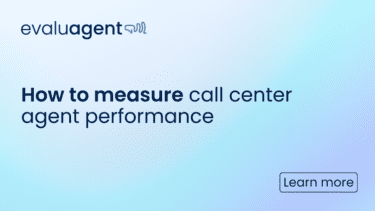How to Measure Call Center Agent Performance


Call centers play a vital part in the UK economy, with the industry’s revenue expected to reach £2.5 billion over the next five years.
Call center agents assist customers across a wide range of sectors — from finance and healthcare to retail and DIY. They serve as a vital point of contact between companies and customers, helping shape customer experiences and drive brand loyalty.
Measuring agent performance isn’t just a formality, it’s a key step in identifying areas for improvement and driving efficiency. This blog will explore how to assess call center agent performance, highlighting key metrics that provide meaningful insights into their effectiveness.
The modern business landscape is highly competitive. Customers value their time more than ever before and expect to receive excellent service.
Measuring call center agent performance is essential because it allows companies to assess the effectiveness of their customer service operations, identify weaknesses, and optimize processes. This, in turn, should improve customer experiences and boost brand reputation.
Call centers can utilize various metrics to gain insights into customer interactions and assess agent performance. Here are some key performance metrics that shed light on the effectiveness of call center agents:
Speed is crucial when it comes to measuring agent performance as long wait times can cause customer frustration and abandonment. In fact, a recent survey revealed that 44% of customers are unsatisfied with a 5-15 minute wait time.
Average Handle Time (AHT) is a key metric used to assess call center performance. This is the total duration an agent spends handling a customer call, from initiation to resolution. A lower AHT suggests that the agent is resolving the issue efficiently, leading to higher customer satisfaction and productivity.
Customer satisfaction is arguably the most important metric for measuring agent performance. It is a direct reflection of the agent’s ability to understand customer needs, offer effective solutions, and provide a positive interaction.
Call centers can gain valuable insights into the customer experience through post-interaction surveys and feedback.
Surveys also show that customers become frustrated when they are transferred between agents and need to re-explain issues multiple times. According to Salesforce, 83% of customers expect their issues to be solved during their first interaction with a call center agent.
First Call Resolution (FCR) can shed light on an agent’s competence and problem-solving skills. It highlights the percentage of customer issues that are resolved during the initial contact, without the need for transfers or follow-up calls. A high FCR suggests that an agent is using resources efficiently and providing a high level of service.
As mentioned, modern customers value immediacy and expect their issues to be resolved quickly. Failing to provide efficient customer service can lead to a high abandonment rate — the percentage of callers who disconnect before reaching a call center agent or receiving a resolution.
A high abandonment rate is often the result of issues such as long wait times or ineffective call routing. Monitoring and reducing this rate is crucial in ensuring a seamless customer journey and improving agent performance.
Service Level refers to the percentage of calls that an agent answers within a specified timeframe. This metric is crucial in assessing the efficiency of call center operations.
A high Service Level percentage indicates that a company is providing attentive service by answering a large portion of customer calls quickly. However, call center agents must strike a balance between offering great service and effectively managing call volume.
Setting an overly high Service Level target might put undue pressure on agents, potentially compromising the quality of customer interactions. Whereas, setting the metric too low could result in extended wait times, thus testing customers’ patience and leading to dissatisfaction.
Quality Monitoring is the process of evaluating call center interactions to assess agent performance against predefined quality standards. This evaluation is often done through call center recordings and feedback.
Monitoring quality assurance provides managers with actionable insights into agent communication skills, problem-solving abilities, and compliance with company protocols. This metric helps companies drive continuous agent improvement and elevate customer service.
Measuring agent performance is a must in today’s competitive business landscape. Various metrics can be used to gain insights into customer interactions, helping companies optimize processes and meet customer expectations.
At EvaluAgent, we offer industry-leading call center quality assurance software that gives you a complete overview of your call center’s strengths and areas for improvement, business and helping you drive agent performance and provide unrivalled customer service.
Learn more by checking out our product tours, or schedule a demo today.